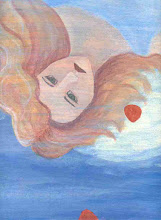I bought this book in 1996. I was not a children's librarian then, nor did I ever expect to become one; I did not have any children then, nor did I expect to ever have any. I did, however, have a cat named Psyche. I also owned and loved the book Till We Have Faces by C. S. Lewis and had two versions of The Golden Ass (where the story of Cupid and Psyche first appeared in written form). The spectacular cover art of this edition made me pick up Cupid and Psyche, and when I flipped through the book, I saw that the retelling was very well done. So I bought it.
I do not mean to dismiss the skill involved in a retelling of a classic myth by dwelling on the artwork in this book. It is no easy task -- I have attempted it myself with Before the Beast -- but the illustrations in this version of the Cupid and Psyche tale are breathtakingly gorgeous. I have read comparisons of K. Y. Craft's work to the Pre-Raphelite Brotherhood. I don't disagree with the comparisons, but I don't think that as a description goes far enough. There is something more than just a PRB influence. I'm not sure what that more is, except that it is magical.










